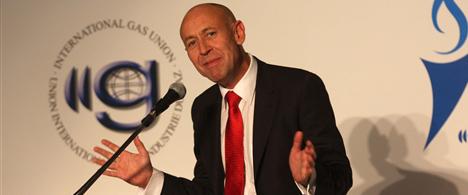
Executive vice president for Natural Gas in StatoilHydro, Rune Bjørnson, gave a speech at the 24th World Gas Conference in Buenos Aires. (Photo: Roberto Eduardo Decurnex)
This was one of the main messages executive vice president for Natural Gas in StatoilHydro, Rune Bjørnson, spelled out in a speech held today, 6 October, at the 24th World Gas Conference (WGC) in Buenos Aires, Argentina. WGC, held every third year, is a key meeting place for players in the industry across the globe.
Bjørnson pointed to that in the 1980s the world’s total consumption of natural gas amounted to some 1500 billion cubic metres (bcm). In 2000 the level was more than 2500 bcm, and last year world consumption passed 3000 bcm.
Increased reserves
A similar growth trend can be observed in reserves. In 1988 proven natural gas reserves stood at a little less than 110 trillion cubic metres (tcm). In 2008 the figure stands at more than 185 tcm – a growth of 75 per cent in twenty years.
Transforming the gas industry
Natural gas represents some 22 per cent of the world’s total primary energy consumption.
Bjørnson identified three ‘game changers’ shaping the gas industry in the long term. The first is international trading of gas. Liquefied natural gas (LNG) has contributed to turn international gas trading into a blossoming business.
“In the future we will need to move even more gas over longer distances and across borders even by way of pipelines,” he said.
Removing trade barriers for gas
“Free and fair trade in gas – including transparent and reasonable transit conditions – is essential to enable natural gas to fulfil its role as a reliable fuel in the future,” he continued.
Natural gas is plentiful
Secondly, with unconventional gas (i.e. shale gas and coal bed methane) coming into the supply picture, the reserves situation has completely changed – reserves are more plentiful than ever imagined and will be available for generations to come.
“This has the potential to change the supply and demand balance in many regions, as it has already done in the US,” Bjørnson noted.
A bridge to lower emissions
Third is the issue of climate change.
“I see natural gas as an important vehicle into a low-emissions future. Gas contains less carbon than oil and much less than coal,” said Bjørnson.
There is also an important link between gas and renewable energy. In the power sector, gas turbines are often needed to provide backup and flexibility for intermittent generation – such as wind power.
“So, in order to reduce carbon dioxide emissions and promote more renewable energy, gas is a natural partner,” said Bjørnson.
“I am optimistic about the ability of our industry to deliver with a strength that is at least on a par with our achievements in recent decades,” he added.